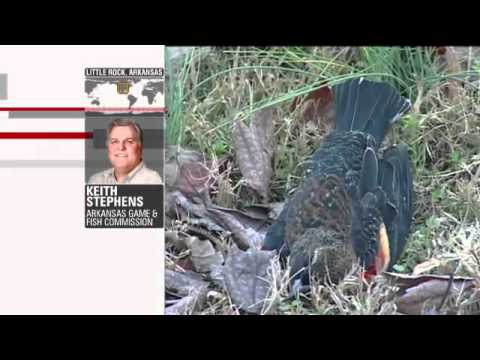
Beebe, Arkansas was the scene of an unusual and alarming event which heralded 2011. Between 11:30 p.m. and midnight on New Year’s Eve, thousands of birds plummeted to the ground over an area about 1.5 kilometres long and 800 metres wide in the town. Most were red-winged blackbirds, though grackles and starlings were also among the dead.
Scary enough as it is if one thinks of something biblical like the End of Days however scarier still if one thinks of something slightly more practical like toxic fumes. Like the proverbial canary in a coal mine, the birds were seen by some as an indicator of some poisonous leak which certainly was supported by the environmental cleanup workers in jumpsuits who descended upon the town New Year’s Day to pick up the thousands of dead birds.
Imaginations were running wild however anything toxic ended up being ruled out. Autopsies performed on several birds showed that they died from blunt force trauma, in other words, they ran into something. Speculation is that something startled the flock, possibly fireworks and the frightened birds took flight. They would have tried to flee but have stayed low and since blackbirds have poor night vision, in the dark ran into one another or various obstructions like buildings.
Adding the entire mystery is another report from Pointe Coupee Parish, Louisiana, on Monday, January 4. About 500 birds covered a quarter-mile stretch of Louisiana Highway 1, reportedly landing face down, together in groups, or on their back with their wings and legs rigidly pointing upwards. Like the Beebe birds, samples from this group were sent away for testing.
Reporters, in speaking with specialists at the U.S. Geological Survey have uncovered what may be a rational explanation. Apparently they have recorded at least 16 other cases in the past 20 years of large numbers of blackbirds dying in contained areas. The agency feels that trauma due to fright is the cause. Some noisy event, more than likely fireworks panicked the roosting birds which flew into frenzy. A bird can fly at 40 mph (almost 56 km/h) so one bird running into another in flight can be fatal. This goes along with preliminary reports about the trauma suffered by the birds. They didn’t die hitting the ground, they were more than likely already dead or severely hurt when they fell.
Meanwhile, fish are spawning their own mystery. Nearly one hundred thousand fresh water drum (a type of fish) washed up dead on the shores on the Arkansas River not far from Ozark. There was another massive fish kill in Chesapeake Bay.
Here in Canada, hundreds of dead gizzard shad fish washed up on shore in the north end of the St. Clair River. A spokesperson from the Ministry of Natural Resources qualified this as a natural occurrence, not the result of something toxic like a chemical spill. They explained that the weekend weather warmed up then it quickly cooled off which would cause a temperature shock. Since only one species was affected, this supports the idea that this was a natural occurrence.
YouTube: 5,000 dead Birds + 100,000 dead Fish in Arkansas (01/01/2011 – USA)
http://www.youtube.com/watch?v=oTKoAeXARZw
Drunken birds die en masse – Feb 11/2005
Back in 2005, Columbia, South Carolina had its own avian mass death but due to intoxication. The enclosed courtyard of a three-story building had numerous holly trees whose berries were fermented. The birds in eating the fruit became drunk. Some were reported so loopy they fell off the branches but others in attempting to fly, slammed into the glass walls surrounding the courtyard. One witness was quoted as saying, "It was like an Alfred Hitchcock movie. It was spooky. You could hear them where they flew into the glass."
About 50 birds died. Groundskeepers have tried to stop the birds from feeding by putting nets over the holly trees.
Click HERE to read more from William Belle
You can publish this article on your website as long as you provide a link back to this page.

Be the first to comment